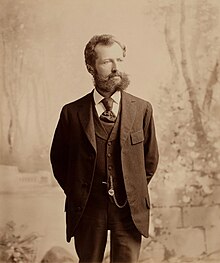Life and career
Mergenthaler was born into a German family in Hachtel, Kingdom of Württemberg. He was the third son of a school teacher, Johann Georg Mergenthaler, from Hohenacker near the city of Waiblingen.
He was apprenticed to a watchmaker in Bietigheim before emigrating to the United States in 1872 to work with his cousin August Hahl in Washington, D.C. Mergenthaler eventually moved with Hahl's shop to Baltimore, Maryland. In 1878, Mergenthaler became a naturalized citizen of the United States. In 1881, Mergenthaler became Hahl's business partner.
Invention of the Linotype
In 1876, Mergenthaler was approached by James O. Clephane and his associate Charles T. Moore, who sought a quicker way of publishing legal briefs. By 1884 he conceived the idea of assembling metallic letter molds, called matrices, and casting molten metal into them, all within a single machine. His first attempt proved the idea feasible, and a new company was formed. Always improving his invention, Mergenthaler further developed his idea of an independent matrix machine.
In July 1886, the first commercially used Linotype was installed in the printing office of the New York Tribune. Here it was immediately used on the daily paper and a large book. The book, the first ever composed with the new Linotype method, was titled, The Tribune Book of Open-Air Sports. Produced by his Mergenthaler Linotype Company, the machine remained a mainstay of the publishing industry until the 1980s.
Death
Mergenthaler died of tuberculosis in Baltimore in 1899.

